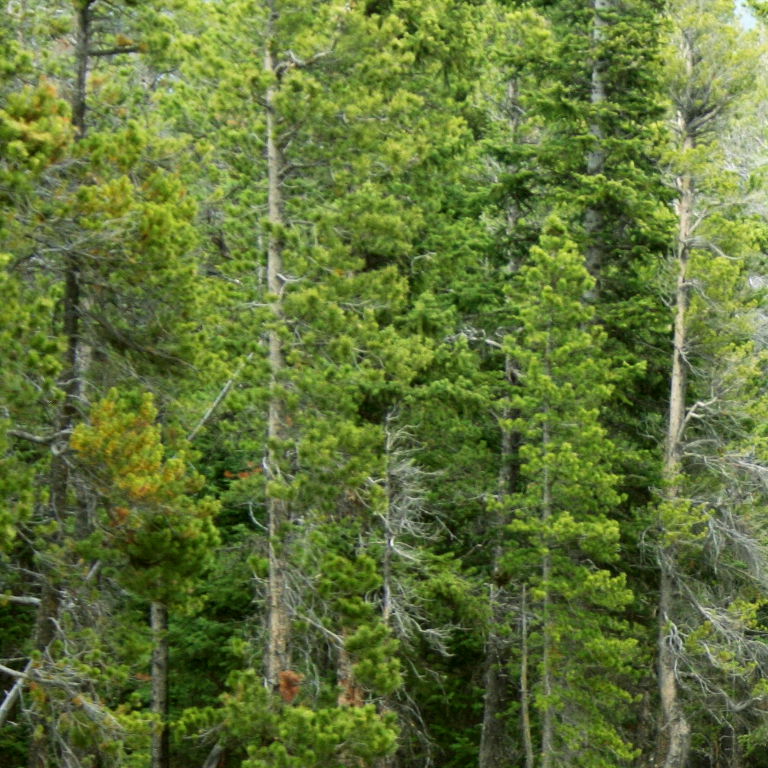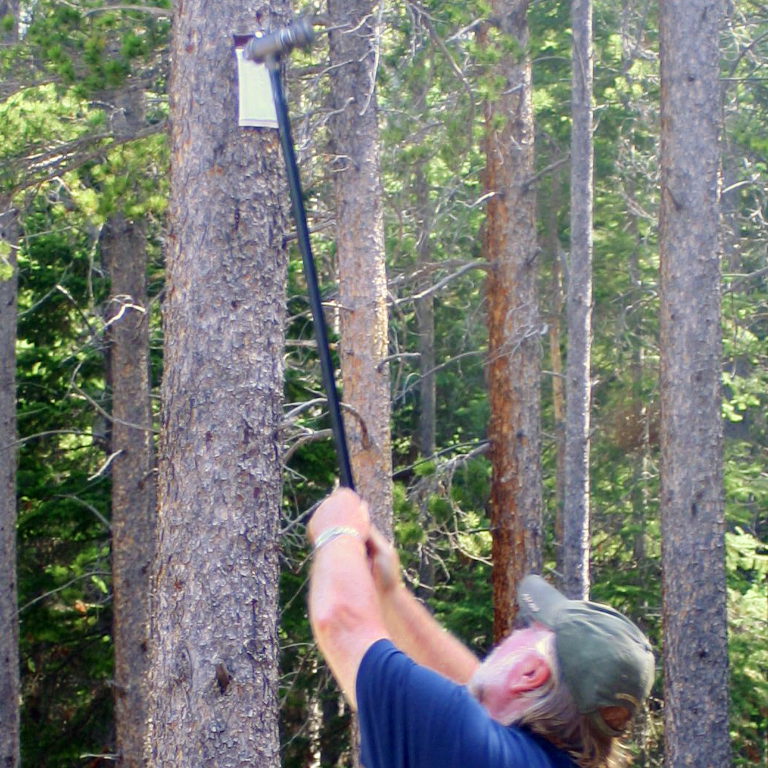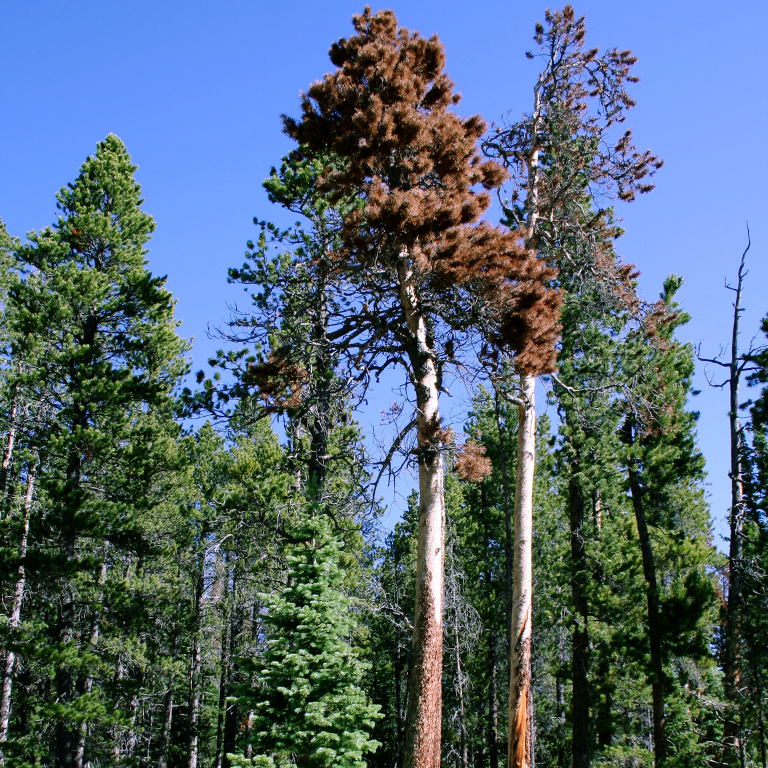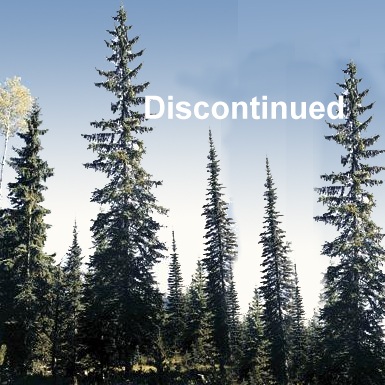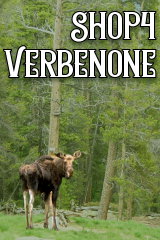
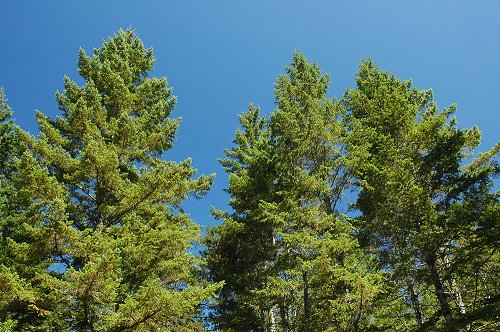
MCH Bubble Caps target only the insects killing your trees. Beneficial insects humans, pets, wildlife and the environment are completely unharmed.
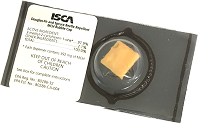
 .
.
MCH Douglas-Fir & Spruce Beetle Repellent helps protect your Fir & Spruce trees.

Douglas-Fir Beetle
The Douglas-fir beetle(Dendroctonus pseudotsuqae. Hopk.) infests and kills Douglas-Fir trees (not to be confused with the Fir Engraver Beetle, also a native bark beetle that attacks true firs but does not attack Douglas-fir because it is not a true fir.) Outbreaks have occurred in fir forests from Alaska to Arizona. Infestations in western United States and up through British Columbia.
Colorado has been particularly hard hit. In Colorado, outbreaks typically occur in the southern part of the state, especially in portions of the Rampart Range, Wet Mountains, Sangre de Cristo/Culebra ranges, La Garita Range, West Elk and Elk mountains, and the southern slopes of the San Juan Mountains. Also west of Ft Collins. Figures are not yet tabulated for the 2019 season.
Normally, Douglas-fir beetles only breed in felled, injured or diseased trees, In hot and dry summers, they can multiply quickly, breeding in slash, stumps, windthrow, and trees weakened by fire, drought, defoliation or disease. Populations expand rapidly in such material and in subsequent generations beetles attack and kill surrounding green trees.
Outbreaks typically start in the damaged areas and often follow devastation caused by Mountain PIne Beetles after the pine beetles have left. Use MCH in these areas to prevent a population build. If not prevented, the Douglas-Fir Beetle population can "explode", attacking and subsequently killing healthy standing Firs.
In the winter, infested trees are often easily identified by the abundance of bark flakes on the snow, which is evidence of feeding activity by woodpeckers.
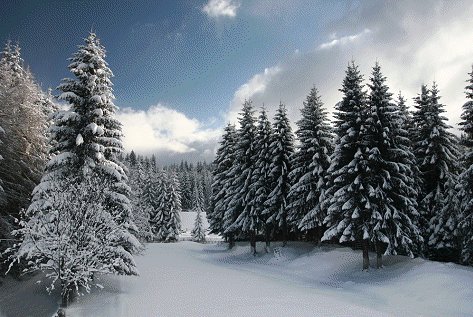
Fir Beetles generally have a one year life cycle. But they start to fly EARLY in the spring. Snow may still be on the ground when the first flight occurs. They start in April and May, when temperatures consistently exceed 60 degrees F, and continue to fly and attack new trees until early June, depending on local conditions. Adults that emerge early may make a second attack later in the summer, typically from late June through August. Individuals that spent the winter as larvae typically emerge as adults in July or August.
MCH Application dates will vary a little with elevation but are typically started by Ap 15 (Get your snowshoes out!) and run through August with peak flights occurring from early June to early July.
In Spring, the newly hatched adults leave the tree of their metamorphosis, seeking out larger trees (usually over 8" diameter if possible) in the surrounding area. (In areas with heavy infestation, beetle hatchlings may take even smaller trees as pressure to get ANY tree increases). When the adults arrive, they begin tunnelling under the bark, lay eggs, which turn to larvae and live through the winter to produce more egg-laying adults to attack more trees. The larvae feed under the bark in the phloem layer, introducing fungi, yeasts, and other organisms that lead to tree death.
Trees attacked early in the Spring may actually produce new adults that will make a 2nd attack in late summer, but the "second flight" usually accounts for less than 10% of the infested trees.
It is estimated that one infested tree will kill at least two and possibly more trees. Thus the exponential devastation occurs.
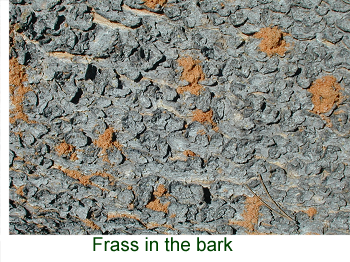
There are few outward signs of infestation. Unlike mountain pine beetles, there are no pitch tubes. Look for small mounds of 'sawdust' (boring dust called Frass) at the base of the tree and in the bark crevice. Boring dust is left when the beetles bore into the bark of the tree. This will have the consistency of flour or fine sawdust and will be reddish in color. However, frass can wash away and attacks may be above eye-level, making it difficult to locate attacked trees. While pitch-tubes are not usually present, many trees will have pitch streaming (clear resin) down the tree bole from the top of the beetle-colonized area.
"Rusting" tree tops are often the first sign of tree damage. Tree foliage discolors several months to a year after the attack, transitioning from green to reddish brown in that time. However, trees may not begin to have dead tops and boughs until the 2nd year after infestation. It's important to identify it before rusting occurs as that might be too late.
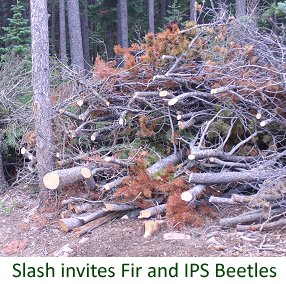
It is critical to remove and properly dispose of infested trees and slash prior to trying to deter beetle populations from attacking good trees in the stand.
Quick Guide to Signs of Fir Beetle Attack
- Egg Galleries straight, vertical, packed with frass (sawdust)
- Larval galleries fanning out from egg gallery
- Red or yellow boring dust in bark crevices or at base of tree (frass)
- No pitch tube
- Resin streamers – strings of resin that look similar to candle wax – generally visible 8 feet or higher on the tree trunk.
- Foliage is dis-colored
This is the most important bark beetle on Douglas-fir throughout its range, and it is not easily confused with other beetle attacks on Douglas-Fir trees.
As always, the best defence against Douglas-Fir Beetle is a healthy stand of trees that are able to defend against attack. Proper spacing, basal area, water and removal of brood trees and unhealthy trees are all important.
MCH is widely used by the USFS for preventing attacks on valuable Douglas-Fir stands. Dense stands of large Douglas-Fir trees are at highest risk of attack. If direct control is deemed necessary, trees can be protected using the anti-aggregation pheromone methylcyclohexanone (MCH), which disrupts beetle aggregation. Combining MCH with salvage of infested trees has been successful at reducing subsequent tree mortality.
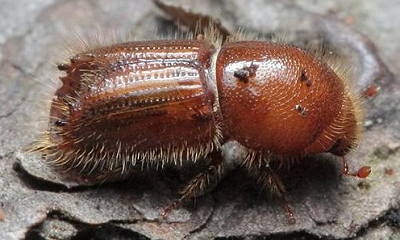
Spruce Beetles
Spruce beetle populations range from Alaska and Newfoundland to as far south as Arizona and New Mexico. The subalpine Engelmann spruce is the primary host tree, but the beetles will infest any spruce tree species within their geographical range, including blue spruce. In Colorado, the beetles are most commonly observed in high-elevation spruce forests above 9,000 feet.
While Blue Spruce are only occasionally attacked, Engelmann spruce trees over 16 inches in diameter are most susceptible to spruce beetle; trees less than 5 inches in diameter are seldom attacked. Freshly killed or damaged trees (e.g. from windthrow or avalanches) are preferred habitat.
The patterns of spruce bark beetle infestation over the landscape correlate most strongly with patterns of windfall episodes, and less so with patterns of temperature and precipitation, which makes sense as they prefer downed trees.
USDA notes that "Spruce beetles prefer down spruce to standing trees. On down (windthrown and cut) trees, spruce beetles commonly colonize the lower, well-shaded surfaces and may colonize the entire length of the trunk, typically up to an 8-inch (20-cm) top. In standing trees, beetle activity is most common in the lower 30 ft or so of the trunk... Spruce forest stands most susceptible to attack are located along drainage bottoms. They usually have a canopy comprised of more than 65% spruce."
Higher temperatures will favor beetles reproduction and induce a transition from one to two generations per year in some areas.
Spruce bark beetles are capable of killing trees only when they reach a certain number. Long-term drought and other factors that weaken the trees' resistance are important, because they determine how many beetles are needed to conquer living trees. The number of weakened trees builds up during the interval between outbreaks, and such trees are quickly consumed during an outbreak. Weakened trees thus function as a kind of fuel for the outbreaks.
Spruce beetles may complete their life cycle in 1 year on warm sites at lower elevations or take up to 3 years in cool, well-shaded locations on north slopes. However, throughout most of its range and in most seasons, two years are generally required for the spruce beetle to complete its life cycle.
Like the Mountain Pine Beetle and the Fir Beetle, females bore into the tree, lay their eggs, and let nature take its course. After the eggs hatch, the spruce beetle larvae spend the winter developing under the bark of their host trees. During the second winter of the 2-year life cycle in standing trees, some beetles overwinter in their pupal sites but the majority, often as high as 95 percent, of the new adults emerge, move to the base of the tree, and bore into the bark near the litter line to overwinter. Overwintering at the base of the infested tree reduces predation by woodpeckers and reduces winter mortality due to extreme cold temperatures. There they lye in wait for Spring to emerge as adults.
Although adults may emerge any time from May to October, depending on temperature, most attacks occur in early summer. Dense stands of large Spruce trees are at highest risk of attack. Look for signs from Mid-May thru July and use MCH to repel the beetles starting in early May in most elevations.
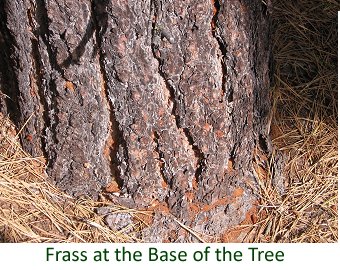
Signs of Spruce Beetle Attack
- Red or yellow boring dust in bark crevices or at base of tree
- Pitch tubes sometimes (but not always) accumulate around the insect boring holes much like Mountain Pine Beetle
- Pitch streamers – strings of resin that look similar to candle wax – generally visible 8 feet or higher on the tree trunk.
- Small, round holes in the bark of an infested tree. These holes usually are a result of mature beetles exiting the tree after they have completed their development under the bark, but they also may indicate spruce beetle entrance and/or ventilation holes.
- Also, look for pieces of bark around the base of the tree. Woodpeckers will often flake off pieces of this thin barked tree in order to feed on the beetles and their larvae. Removing a section of the bark should show tunnels created by beetles in their reproduction process
- Foliage is dis-colored. Infested trees usually do not “fade” (turn yellow-green or reddish) until one or sometimes two years after attack.
Scientists have found that drought negatively affects Engelmann spruce trees, which then have weaker defences against Spruce beetle (Dendroctonus rufipennis), triggering an outbreak in hundreds of thousands of acres in Colorado's forests.
As of 2012, fewer acres of Colorado trees have been affected by spruce beetles than mountain pine beetles, but there are more spruce forests in Colorado than Lodgepole pine, so there's "no reason to expect the percentage mortality to be less or acreage affected to be any less" than it was for the mountain pine beetle epidemic, said Tom Veblen, coauthor of one of the studies and a geography professor at CU.
More than 311,000 acres were killed by spruce beetles in Colorado in 2012, compared to nearly 2 million acres cumulatively by 2018. Infestations seem to be dropping SLIGHTLY in 2019, but are still strong, especially in southern parts of the state like the San Juan and Rio Grande National Forests.
An article published by the Denver Post in October 2017 headline reads "Southwest Colorado forests under attack by pine beetle". Gretchen Fitzgerald, a forester for the U.S. Forest Service’s Columbine District, which manages nearly 700,000 acres of the San Juan National Forest in La Plata and San Juan counties says, "Over the past two decades, more than 120,000 acres of the Weminuche Wilderness — Colorado’s largest designated wilderness area at 488,210 acres — have fallen prey to the destructive spruce beetle."
Spruce beetle continues to spread southward from Colorado, where it has caused extensive spruce mortality - a 55% increase from last year - in New Mexico. Given the heavy spruce beetle activity in southern Colorado, the threat for further massive spruce mortality in New Mexico is high - particularly in the northern half of the state.
As always, the best defence against Spruce Beetle is a healthy stand of trees that are able to defend against attack. Proper spacing, basal area, water and removal of brood trees and unhealthy trees are all important.
- Repels Mountain Pine Beetles
- Non-toxic
- Highly Effective
- Will deter other beetle species
- Usable on many types of pine trees
- Repels Mountain Pine Beetles
- Environmentally friendly
- Controlled release of Verbenone
- No hammer, nails, or pouches.
- Splat applications instructions
- Repels Douglas-Fir Beetles
- Repels Spruce Beetles
- Non-toxic
- Easy Application
- Learn How to Use MCH
© Dataweb, Inc
Telephone: 1-512-282-3003 Fax 1-512-292-7957
4200 Paseo Dr, Austin, Texas 78739
© Copyright 1996- by Dataweb, Inc. All Rights Reserved.

